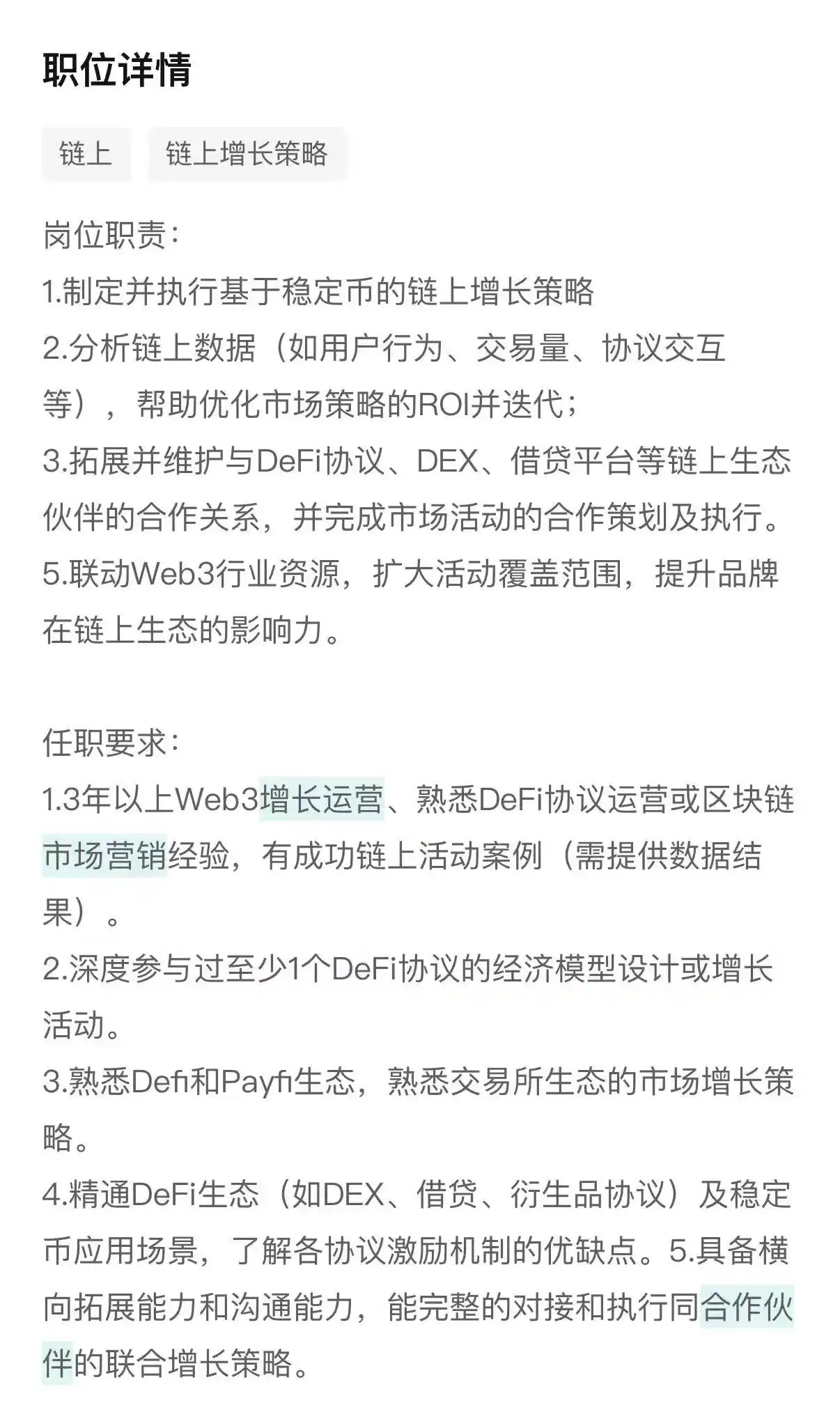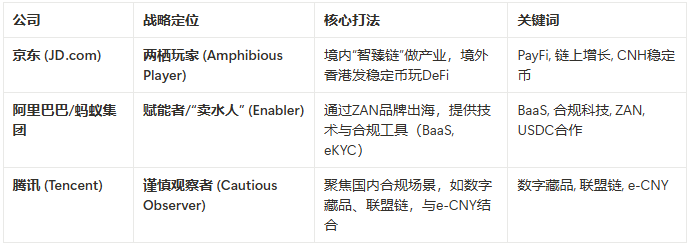Written by: Luke, Mars Finance
A job advertisement can sometimes reveal a company's strategic intentions more than an annual financial report.
In August 2025, a recruitment notice from JD Technology exemplified this. It did not appear on the homepage of mainstream job sites but circulated quietly within the small circle of Web3. What caught attention was not the job title "Stablecoin On-chain Activity Planner" itself, but rather its remarkably "crypto-native" requirements: "Deep involvement in the economic model design of at least one DeFi protocol" and "Proficient in DEX, lending, and derivatives protocols."

This was not a search for a fintech expert to optimize internal payments, but rather a "hunt" for a true on-chain strategist. When an internet giant with an annual revenue exceeding one trillion, rooted in physical retail and supply chains, begins to openly seek talent capable of thriving in a decentralized world, the signal it sends is unmistakable: JD is preparing to place its pieces on the global, permissionless Web3 chessboard.
The "East Wind" from Hong Kong Arrives, JD Enters Accordingly
JD's move did not occur in a vacuum. The timing of the recruitment coincided precisely with a key regulatory change in Hong Kong.
Just days before the recruitment notice surfaced—on August 1, 2025—the long-anticipated "Stablecoin Issuer Licensing Regime" officially came into effect in Hong Kong. This means that after multiple rounds of consultations and sandbox testing, the Hong Kong Monetary Authority (HKMA) has rolled out a compliant and clearly defined "welcome mat" for global stablecoin operators. Therefore, JD's "recruitment drive" is less an exploration into unknown territory and more a precisely calculated move, targeting this newly certified and strategically valuable global financial frontier.
The Secretary for Financial Services and the Treasury of Hong Kong, Christopher Hui, has repeatedly emphasized in public that "while ensuring regulation and risk are controllable, we support the prudent development of the virtual asset market and view stablecoins as a key bridge connecting traditional finance and the virtual asset market."
This favorable wind is timely for tech companies like JD, which have a vast background in mainland China and aspire to connect with global markets. It provides a perfect "outlet"—a legally clear, geographically close, and culturally compatible strategic pivot. By establishing a compliant entity in Hong Kong, JD can legally issue stablecoins pegged to fiat currencies (such as offshore RMB CNH or HKD), thereby circumventing the strict regulations on cryptocurrencies in mainland China and directly participating in global on-chain economic activities.
JD's recruitment was announced immediately after the regulations took effect, which is no coincidence but rather a long-planned "seizing the opportunity." The chessboard is set, and JD clearly does not want to be a mere spectator.
PayFi: Financial Lego Beyond Payments
If Hong Kong's compliant environment is the "timing" for JD's stablecoin project, then an unassuming term in the job description—PayFi—reveals its true "geographical advantage" and core ambition.
PayFi, short for Payment Finance, is a concept originating from the crypto-native world. It goes far beyond simply "paying with cryptocurrency"; its core is to seamlessly integrate payment actions with complex financial services through smart contracts, endowing every flow of funds with programmability.
Imagine a scenario in JD's business: a small to medium-sized enterprise supplying goods to JD previously had to wait up to 90 days to receive payment, creating significant financial pressure. What happens under the PayFi model?
Once JD confirms receipt of goods, the system can generate an on-chain certificate (NFT or fungible token) representing this accounts receivable and immediately send it to the supplier. The supplier does not have to wait 90 days but can instantly use this "digital promissory note" as collateral in a DeFi lending protocol to obtain immediate liquidity; or it can even be split and traded as payment to upstream raw material suppliers. The entire process is executed automatically by code, making it efficient, transparent, and cost-effective.
This is the power of tokenizing Real World Assets (RWA) combined with PayFi, and it is one of the most exciting narratives in the crypto industry in 2025. Jenny Johnson, CEO of asset management giant Franklin Templeton, has asserted: "We believe that tokenizing real-world assets will reshape the entire financial services industry. This is one of the most significant applications of blockchain technology."
For JD, which has a vast number of merchants, a complex supply chain network, and hundreds of millions of users, it harbors trillions of dollars in "real-world assets"—accounts receivable, warehouse receipts, logistics orders, and consumer credit. Activating these assets on-chain through stablecoins and the PayFi model is akin to unblocking the body's meridians, and the energy it can release will be exponential. This not only reduces costs and increases efficiency for existing supply chain finance operations but also creates a brand new, programmable financial infrastructure.
"Amphibious Operations": Different Paths to Web3 for Giants
JD's clear focus on stablecoins and DeFi has led it to carve out a distinctly different path in the Web3 exploration among Chinese tech giants. If we compare horizontally, an interesting picture emerges:

As shown in the table above, Alibaba's Ant Group appears more like a "water seller" in its Web3 layout. Its ZAN brand launched in Hong Kong focuses on providing compliance technology components such as e-KYC (electronic Know Your Customer) and AML (anti-money laundering) for Web3 developers, as well as BaaS (Blockchain as a Service). Its strategy is to "empower," helping others to "strike gold" rather than personally diving in. Recent reports of its proprietary chain plan integrating the US dollar stablecoin USDC also confirm its inclination to collaborate with established ecosystems rather than starting from scratch.
Tencent, on the other hand, is more cautious, with most of its actions revolving around alliance chains and digital collectibles in areas where domestic policies are clear, maintaining a considerable distance from the public chain world.
In this context, JD's strategy stands out as particularly unique and aggressive. It is not content to be merely a technology service provider but has chosen an "amphibious operation" path:
- Inland: Its self-developed "Zhi Zhen Chain" continues to delve into industry blockchain in a permissioned environment, serving anti-counterfeiting traceability, digital evidence, etc., embracing regulation, connecting with digital RMB (e-CNY), and strengthening the compliant "industrial digitalization" foundation.
- Offshore: It utilizes Hong Kong as a window, personally stepping in to become a "player," issuing its own stablecoin, operating its own on-chain ecosystem, and directly fishing in the vast ocean of DeFi, exploring the stars and seas of "financial assetization."
This dual-track strategy ensures the stability and compliance of domestic operations while opening up limitless imaginative space for the group's future.
From E-commerce Empire to On-chain Economy
JD's move marks an important turning point. It signifies that the integration of top Web2 giants with Web3 is transitioning from theoretical discussions and marginal explorations to deep integration with core business operations.
In the past, discussions often revolved around how Web3 would "disrupt" Web2. However, JD's case may reveal another possibility: not disruption, but "elevation." Web2 giants will not be easily replaced; they will leverage their vast user bases, rich application scenarios, and strong capital to absorb Web3 technologies and concepts, evolving into a new, more powerful hybrid form.
Of course, the road ahead is not smooth. From recruiting a position to truly establishing a thriving on-chain ecosystem, JD must overcome multiple obstacles, including technology integration, financial compliance, market education, and user habits. It will face scrutiny not only from traditional financial institutions but also fierce competition from the crypto-native world.
Nevertheless, when JD, this trillion-level commercial giant, begins to adjust its course and sail into the deep waters of DeFi, the entire industry should pay close attention. Because this is not just about the future of one company; it may be painting a blueprint for us: how an e-commerce empire can evolve into an efficient, transparent, and global on-chain economy through the bridge of stablecoins. On that day, the endpoint of transactions will no longer be the completion of payments, but the beginning of another phase of financial value creation.
免责声明:本文章仅代表作者个人观点,不代表本平台的立场和观点。本文章仅供信息分享,不构成对任何人的任何投资建议。用户与作者之间的任何争议,与本平台无关。如网页中刊载的文章或图片涉及侵权,请提供相关的权利证明和身份证明发送邮件到support@aicoin.com,本平台相关工作人员将会进行核查。




